Abstract
Reticulate bodies from a type C and elementary bodies from a type L2 strain of Chlamydia trachomatis were isolated and used as antigens in an enzyme-linked immunosorbent assay (ELISA). Results obtained for human sera with these two antigens used in the ELISA were compared with each other and with results obtained for the same sera by the micro-immunofluorescence test. Negative control populations included cloistered nuns and children with respiratory infections. Populations at risk for chlamydial infection consisted of 42 men with nongonococcal urethritis attending a sexually transmitted diseases clinic and 42 college women who had contact with men with nongonococcal urethritis. ELISAs done with the two antigens were equivalent to each other and to the micro-immunofluorescence test in the ability to predict the presence or absence of infection. None of the tests had high predictive values for the men with urethritis. However, the negative predictive value of both the micro-immunofluorescence test and the elementary body ELISA was 0.92 for the college women. Such serological tests may be of value in screening selected populations for subclinical infections with C. trachomatis.
Full text
PDF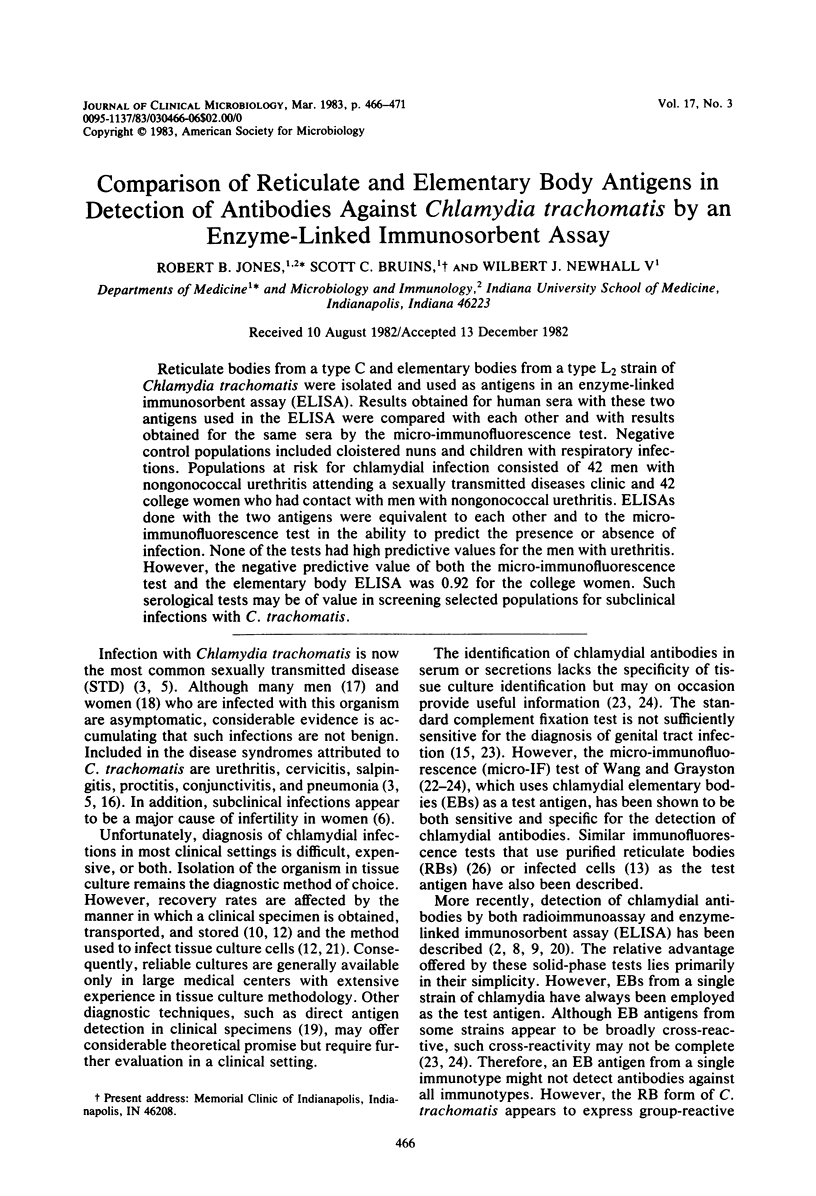
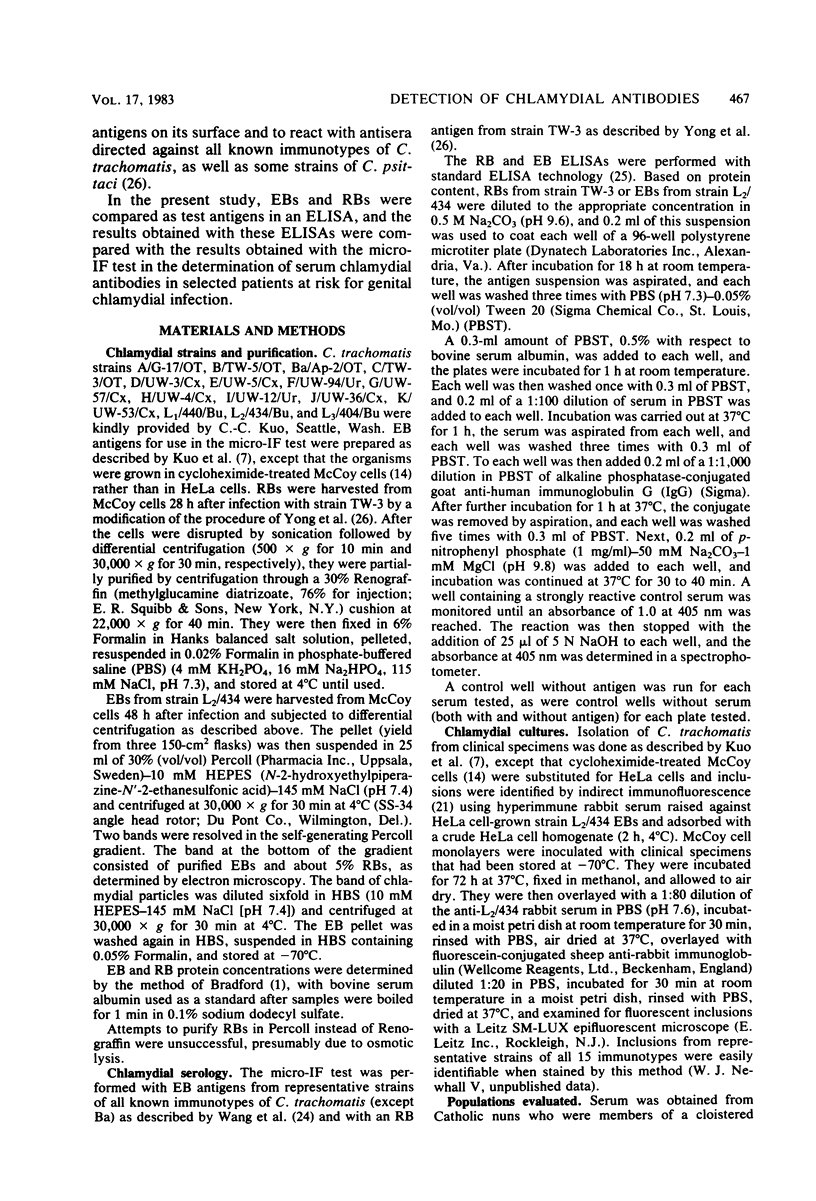
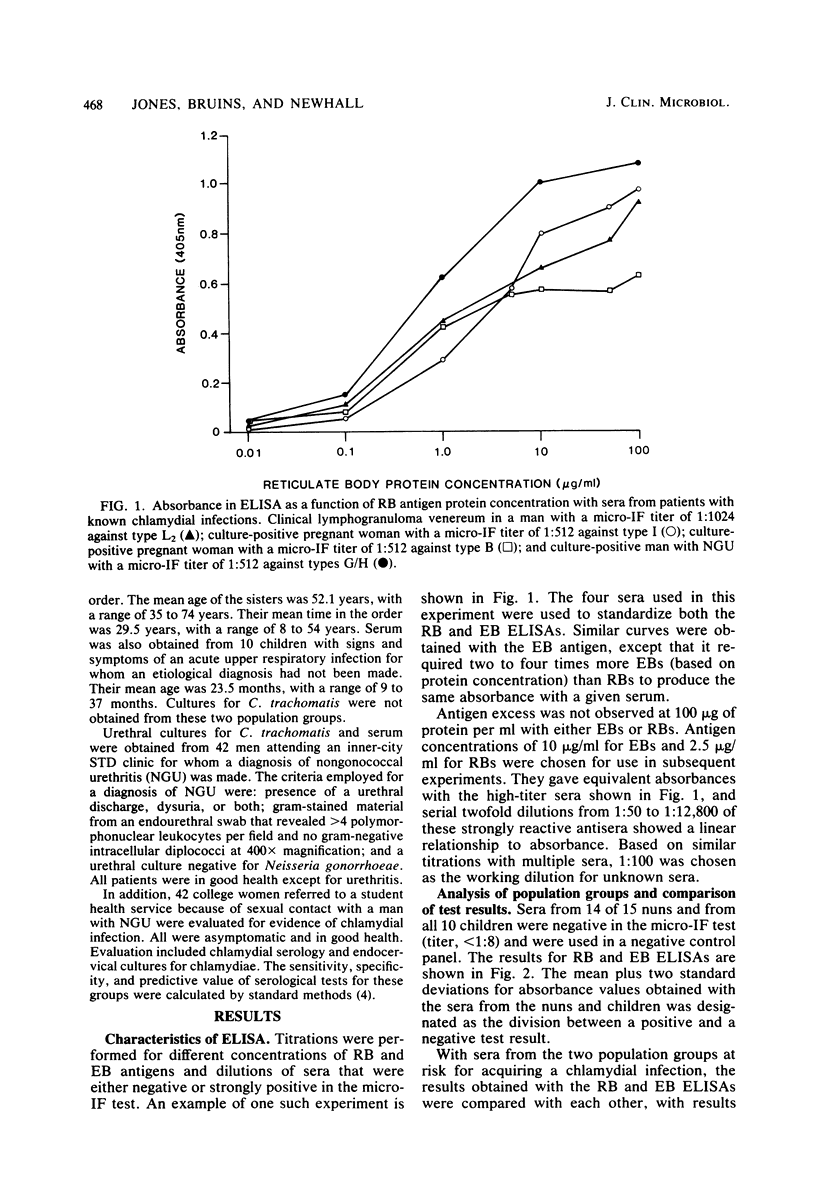
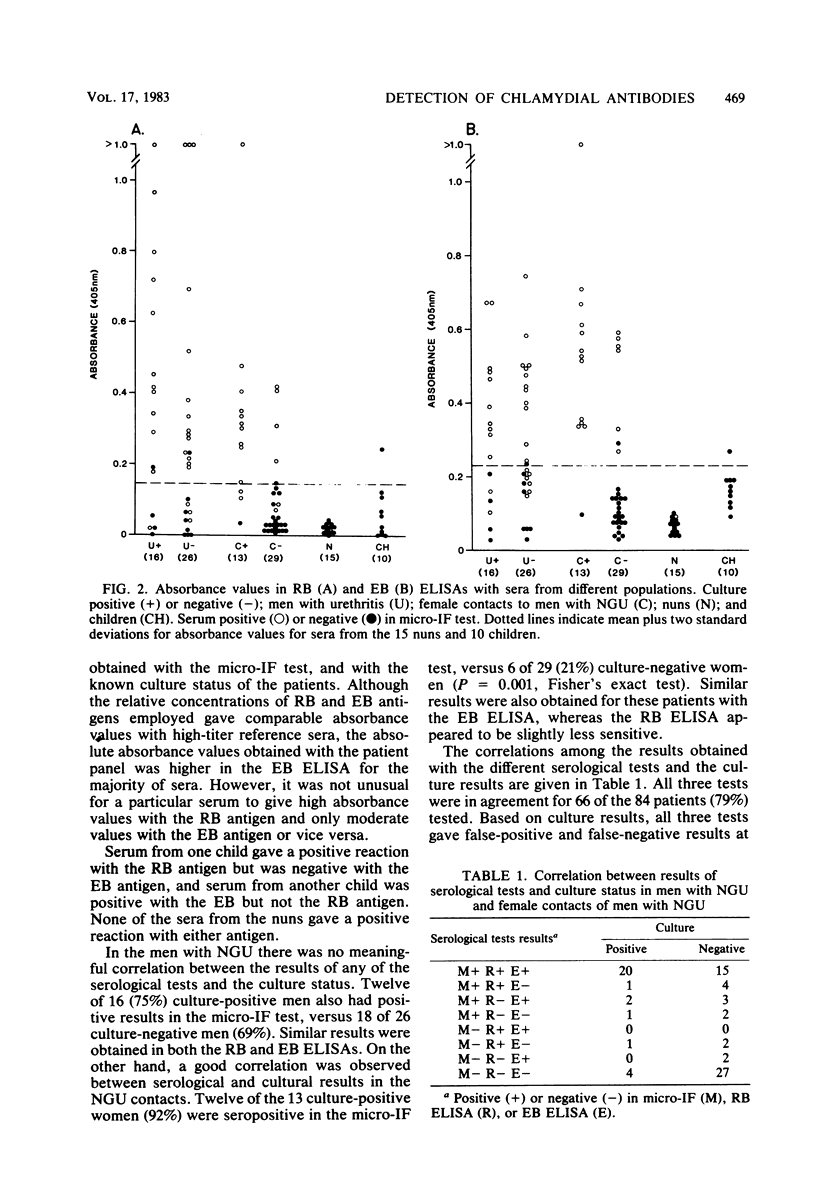
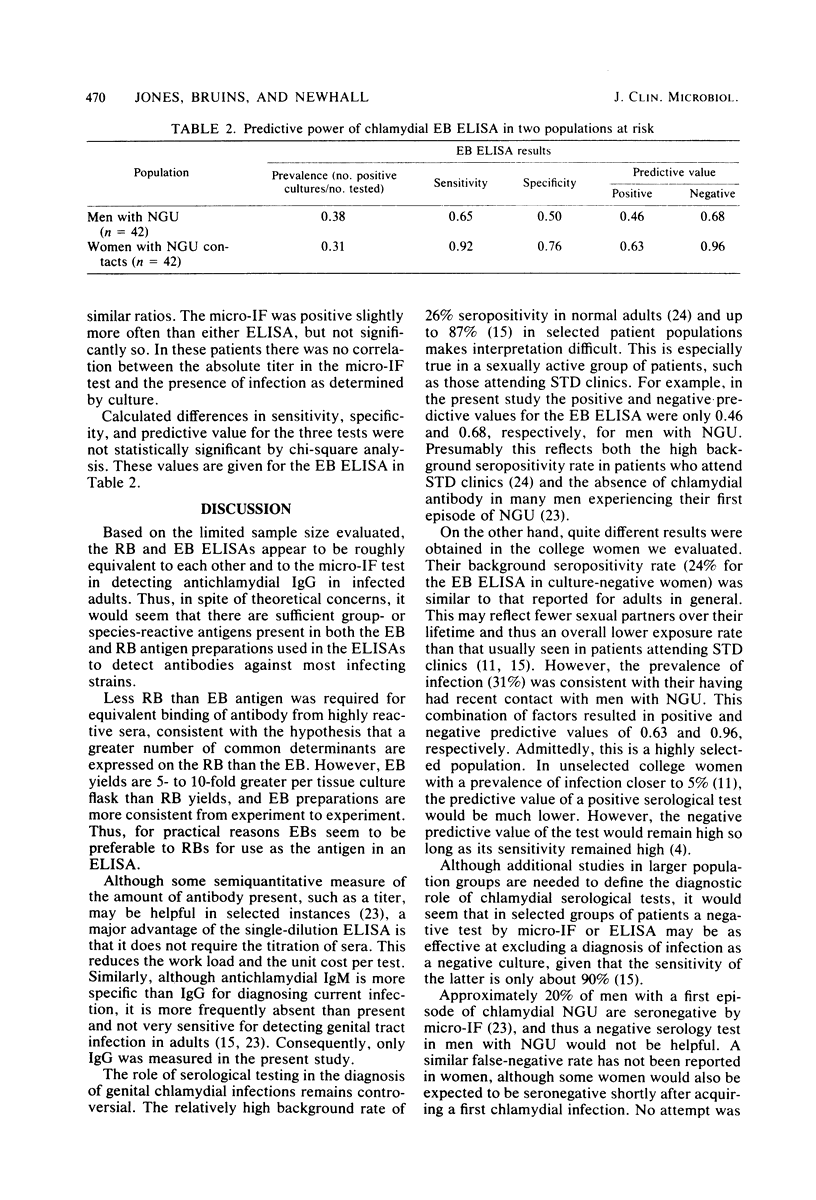
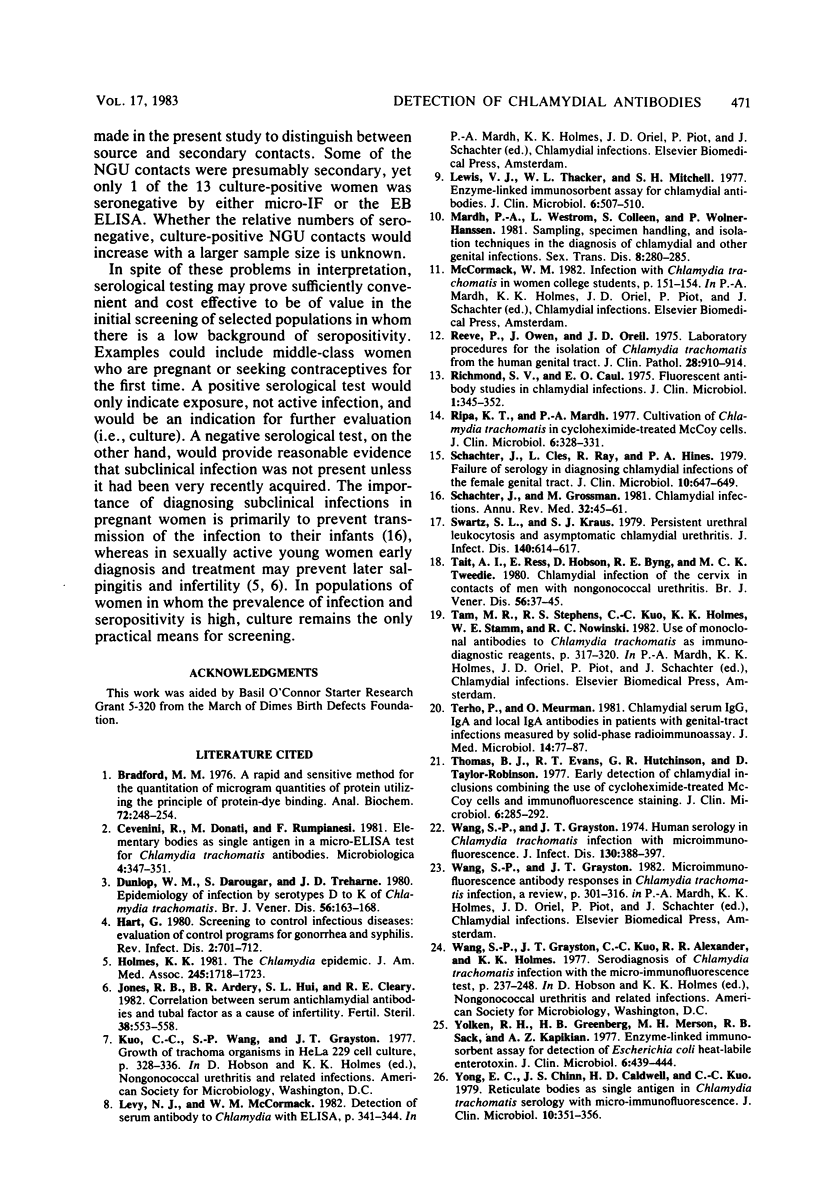
Selected References
These references are in PubMed. This may not be the complete list of references from this article.
- Bradford M. M. A rapid and sensitive method for the quantitation of microgram quantities of protein utilizing the principle of protein-dye binding. Anal Biochem. 1976 May 7;72:248–254. doi: 10.1016/0003-2697(76)90527-3. [DOI] [PubMed] [Google Scholar]
- Dunlop E. M., Darougar S., Treharne J. D. Epidemiology of infection by serotypes D to K of chlamydia trachomatis. Br J Vener Dis. 1980 Jun;56(3):163–168. doi: 10.1136/sti.56.3.163. [DOI] [PMC free article] [PubMed] [Google Scholar]
- Hart G. Screening to control infectious diseases: evaluation of control programs for gonorrhea and syphilis. Rev Infect Dis. 1980 Sep-Oct;2(5):701–712. doi: 10.1093/clinids/2.5.701. [DOI] [PubMed] [Google Scholar]
- Holmes K. K. The Chlamydia epidemic. JAMA. 1981 May 1;245(17):1718–1723. [PubMed] [Google Scholar]
- Jones R. B., Ardery B. R., Hui S. L., Cleary R. E. Correlation between serum antichlamydial antibodies and tubal factor as a cause of infertility. Fertil Steril. 1982 Nov;38(5):553–558. doi: 10.1016/s0015-0282(16)46634-3. [DOI] [PubMed] [Google Scholar]
- Lewis V. J., Thacker W. L., Mitchell S. H. Enzyme-linked immunosorbent assay for chlamydial antibodies. J Clin Microbiol. 1977 Nov;6(5):507–510. doi: 10.1128/jcm.6.5.507-510.1977. [DOI] [PMC free article] [PubMed] [Google Scholar]
- Mårdh P. A., Weström L., Colleen S., Wølner-Hanssen P. Sampling, specimen handling, and isolation techniques in the diagnosis of Chlamydial and other genital infections. Sex Transm Dis. 1981 Oct-Dec;8(4):280–285. doi: 10.1097/00007435-198110000-00007. [DOI] [PubMed] [Google Scholar]
- Reeve P., Owen J., Oriel J. D. Laboratory procedures for the isolation of chlamydia trachomatis from the human genital tract. J Clin Pathol. 1975 Nov;28(11):910–914. doi: 10.1136/jcp.28.11.910. [DOI] [PMC free article] [PubMed] [Google Scholar]
- Richmond S. J., Caul E. O. Fluorescent antibody studies in chlamydial infections. J Clin Microbiol. 1975 Apr;1(4):345–352. doi: 10.1128/jcm.1.4.345-352.1975. [DOI] [PMC free article] [PubMed] [Google Scholar]
- Ripa K. T., Mårdh P. A. Cultivation of Chlamydia trachomatis in cycloheximide-treated mccoy cells. J Clin Microbiol. 1977 Oct;6(4):328–331. doi: 10.1128/jcm.6.4.328-331.1977. [DOI] [PMC free article] [PubMed] [Google Scholar]
- Schachter J., Cles L., Ray R., Hines P. A. Failure of serology in diagnosing chlamydial infections of the female genital tract. J Clin Microbiol. 1979 Nov;10(5):647–649. doi: 10.1128/jcm.10.5.647-649.1979. [DOI] [PMC free article] [PubMed] [Google Scholar]
- Schachter J., Grossman M. Chlamydial infections. Annu Rev Med. 1981;32:45–61. doi: 10.1146/annurev.me.32.020181.000401. [DOI] [PubMed] [Google Scholar]
- Swartz S. L., Kraus S. J. Persistent urethral leukocytosis and asymptomatic chlamydial urethritis. J Infect Dis. 1979 Oct;140(4):614–617. doi: 10.1093/infdis/140.4.614. [DOI] [PubMed] [Google Scholar]
- Tait I. A., Rees E., Hobson D., Byng R. E., Tweedie M. C. Chlamydial infection of the cervix in contacts of men with nongonococcal urethritis. Br J Vener Dis. 1980 Feb;56(1):37–45. doi: 10.1136/sti.56.1.37. [DOI] [PMC free article] [PubMed] [Google Scholar]
- Terho P., Meurman O. Chlamydial serum IgG, IgA and local IgA antibodies in patients with genital-tract infections measured by solid-phase radioimmunoassay. J Med Microbiol. 1981 Feb;14(1):77–87. doi: 10.1099/00222615-14-1-77. [DOI] [PubMed] [Google Scholar]
- Thomas B. J., Evans R. T., Hutchinson G. R., Taylor-Robinson D. Early detection of chlamydial inclusions combining the use of cycloheximide-treated McCoy cells and immunofluorescence staining. J Clin Microbiol. 1977 Sep;6(3):285–292. doi: 10.1128/jcm.6.3.285-292.1977. [DOI] [PMC free article] [PubMed] [Google Scholar]
- Wang S. P., Grayston J. T. Human serology in Chlamydia trachomatis infection with microimmunofluorescence. J Infect Dis. 1974 Oct;130(4):388–397. doi: 10.1093/infdis/130.4.388. [DOI] [PubMed] [Google Scholar]
- Yolken R. H., Greenberg H. B., Merson M. H., Sack R. B., Kapikian A. Z. Enzyme-linked immunosorbent assay for detection of Escherichia coli heat-labile enterotoxin. J Clin Microbiol. 1977 Nov;6(5):439–444. doi: 10.1128/jcm.6.5.439-444.1977. [DOI] [PMC free article] [PubMed] [Google Scholar]
- Yong E. C., Chinn J. S., Caldwell H. D., Kuo C. C. Reticulate bodies as single antigen in Chlamydia trachomatis serology with microimmunofluorescence. J Clin Microbiol. 1979 Sep;10(3):351–356. doi: 10.1128/jcm.10.3.351-356.1979. [DOI] [PMC free article] [PubMed] [Google Scholar]


